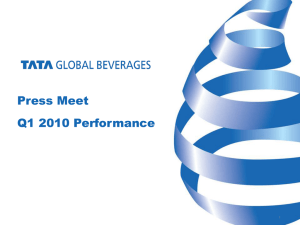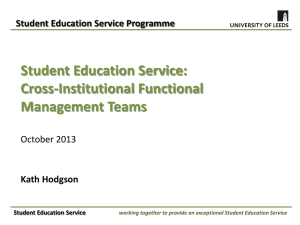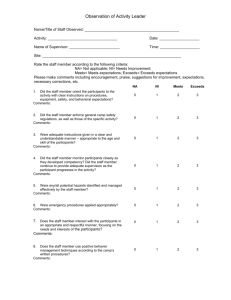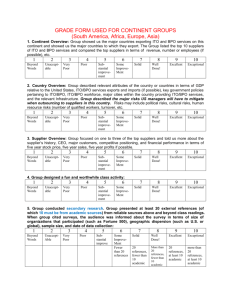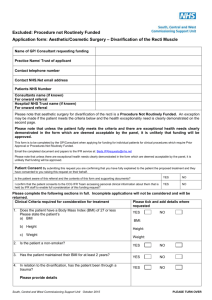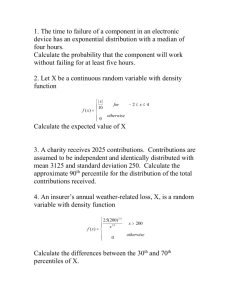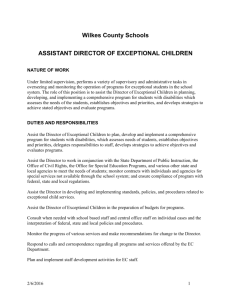Faculty Evaluation Task Force Poll Results
advertisement
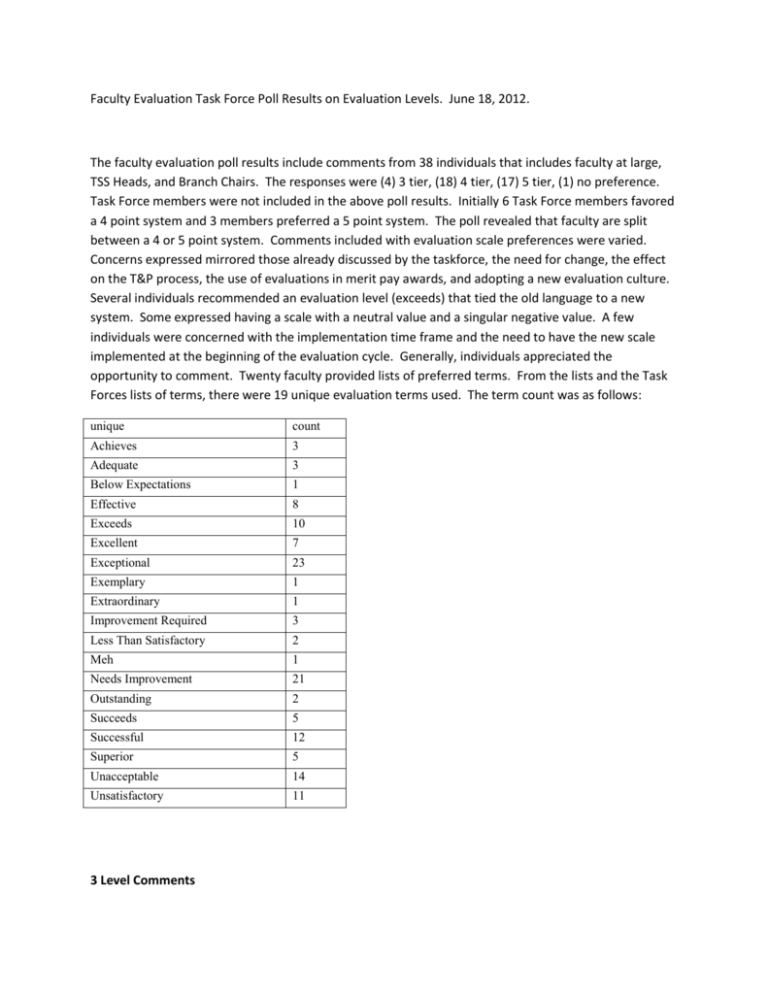
Faculty Evaluation Task Force Poll Results on Evaluation Levels. June 18, 2012. The faculty evaluation poll results include comments from 38 individuals that includes faculty at large, TSS Heads, and Branch Chairs. The responses were (4) 3 tier, (18) 4 tier, (17) 5 tier, (1) no preference. Task Force members were not included in the above poll results. Initially 6 Task Force members favored a 4 point system and 3 members preferred a 5 point system. The poll revealed that faculty are split between a 4 or 5 point system. Comments included with evaluation scale preferences were varied. Concerns expressed mirrored those already discussed by the taskforce, the need for change, the effect on the T&P process, the use of evaluations in merit pay awards, and adopting a new evaluation culture. Several individuals recommended an evaluation level (exceeds) that tied the old language to a new system. Some expressed having a scale with a neutral value and a singular negative value. A few individuals were concerned with the implementation time frame and the need to have the new scale implemented at the beginning of the evaluation cycle. Generally, individuals appreciated the opportunity to comment. Twenty faculty provided lists of preferred terms. From the lists and the Task Forces lists of terms, there were 19 unique evaluation terms used. The term count was as follows: unique count Achieves 3 Adequate 3 Below Expectations 1 Effective 8 Exceeds 10 Excellent 7 Exceptional 23 Exemplary 1 Extraordinary 1 Improvement Required 3 Less Than Satisfactory 2 Meh 1 Needs Improvement 21 Outstanding 2 Succeeds 5 Successful 12 Superior 5 Unacceptable 14 Unsatisfactory 11 3 Level Comments Frankly I fail to see the inadequacies with the current system: you're doing your job, your doing your job really well, or your not doing your job. …, the idea of using that (merit raise) as any justification for change is ridiculous. For starters, I’d like to know if and why the 3-point scale is problematic in the 1st place! We certainly don’t need 5 points. If someone “needs improvement” the extent doesn’t matter in the evaluation process. It is assumed that the supervisor is drawing up a plan, and the degree of improvement will be assessed the following year. I am concerned about the impact on the T&P process of moving from 3 points to more, and I think we need to deeply consider all the ramifications before making adjustments. For T&P, candidates need to show distinction in Criterion 1 and distinction in 2 or 3 (with strength if less than distinction). Adding more points to the evaluation process would muddy the distinction findings. For example, is it possible to show distinction if you are not rated at the very top category? We must proceed very cautiously when considering the delicate relationship between evaluation rankings and T&P considerations, and I don’t think an hour’s discussion or a brief task force’s assignment is sufficient for evaluating the unintended consequences of any changes. One option is to maintain the 3 point scale (needs improvement, meets/succeeds, exceeds) for individual criteria, and perhaps consider a 4 point scale for an “overall” (needs improvement, meets/succeeds, exceeds, super-exceptional) judgment. This would help for merit (isn’t that what the exercise is about?) but would not negatively impact the T&P process. We must take great care when judging the criteria, since the 1st criterion is 80-90% of our jobs and therefore should carry a different weight from 2nd and 3rd. And we must always remember that the annual evaluations and T&P considerations are different animals, and their interplay must be managed very, very carefully. I think 5 is overkill. The current 3 levels are probably sufficient since the evaluator also should explain why they assigned that level (i.e., if you're on the cusp then you get Needs Improvement/Does Not Meet AND your supervisor explains why). I can see having 4 levels if some evaluators feel they really need to point out truly exceptional performance, but again I think this can be done using 3 levels plus the explanation. I don't envy you having to boil all of this down into one recommendation! I prefer the 3 point scale, but there is something to say for the four point one. 4 Level Comments I don’t know that it matters that much. Five does not necessarily provide more clarity than four. Furthermore, I don’t think it’s possible to come up with a “neutral” rating. (Is effective supposed to be neutral? It’s sort of neutral.) I lean towards four, but if you go with five I suggest the following: Exceptional Successful Effective Meh Unsatisfactory I believe a 4 tier scale (2 pos, 1 neutral, 1 neg) would be adequate Thank you for seeking the opinion of the faculty who will be evaluated. In accordance with the logical practices developed by the math department, an even numbered scale would be preferable. Statistically, even numbered scales remove the possibility for a neutral value and create more meaningful data. In this case, I would vote for the 4 point scale with no neutral. However, if there is need for more differentiation of categories than a 4 point scale provides, a 6 point scale would be preferable to a 5 point scale. I really appreciate you seeking our opinions prior to the open discussion. I prefer a four point scale. The first scale on the document you sent out seems most reasonable. I favor the 4 tier approach. There needs to be an in-between category above ACHIEVES and below EXCEEDS; however, I feel only one category below ACHIEVES is necessary. I think there are different levels of good (average, good, superior), but only one of bad. As for wording I think NEEDS IMPROVEMENT, ACHIEVES, EXCEEDS, EXCEPTIONAL (the last one – the highest category – might use a better word). I agree with… I prefer 4 with the following choice of wording: Exceptional, Successful, Adequate, Needs Improvement "Unacceptable" seems to reflect poorly on our hiring practices. "Superior" seems comparative: I believe evaluation is NOT meant to compare workers with each other as much as against an ideal or their previous performance. I think the 4 tier system sounds easier to manage then 5. 2 positives, a neutral, and a negative seems fine. However, I also believe that it will be difficult to quantify the difference between exceeding expectations and outstanding. If we are currently required to exceed expectations in 2 of the three categories in order to achieve tenure, will there be an effort to require outstanding performance in one area? Is the outstanding designation meant to ensure merit pay in the case of someone who has achieved a big win with a book or serious national recognition? Will Outstanding be the new exceeds? Will a neutral designation of “meets expectations” indicate someone on the cusp of failure rather than someone doing their job diligently, if not brilliantly? I guess what I’m saying is that I would prefer 4 levels over 5, but I’m not entirely sure that it is a particularly useful change and I believe it may generate difficulties and impact moral in a negative way. I prefer the 4 tier system. My vote is for 4 levels with 2 positive and 2 negative. I prefer 4 categories and that they be Supperior/Exceptional/- Exceeds Successful Improvement Required Unsatisfactory/Unacceptable. I expect that regardless of the category and wording, consistent definitions and training in the application of the terms by supervisors will be needed. I am always concerned that employees hear negative/ need improvement feedback throughout the year when there are concerns and not only at the time of evaluation. I would prefer the version with 4 categories Exceptional-Successful-Needs Improvement-Unacceptable (i.e. 2 positive categories and 2 negative categories with the upper negative category being a warning). Also, your report indicated that the earliest this model could be implemented is in the 2012-2013 evaluation period. I don’t think it would be appropriate to implement it until the beginning of the next evaluation period – then people would know from the beginning of the evaluation period what the model is that they are being evaluated upon. My selection is below, Exceptional, Successful, Needs Improvement, Unacceptable. 5 Level Comments … expressed her preference for five categories with the following terms: Extraordinary, Outstanding (or Excellent), Effective, Needs Improvement, and Unsatisfactory. My preference is for a 5 point scale. I would prefer a 5 point scale. Thanks for the work the committee is doing on this issue. I think I would prefer the five tier option: Superior, Exceeds, Effective, Less Than Satisfactory, Unsatisfactory. For some reason keeping “Exceeds” seems like it could add a comfortable familiarity to the qualifications but that’s just my two centimes. I prefer the 5 point scale and my 5 point scale preference is: Exceptional, Excellent, Effective, Needs, Improvement, Unacceptable. I prefer 5-tier scale: 3 positive, 2 negative. Based on the attachment, the 5 point scale looks most useful. I will be out for a conference on 6/18, so I look forward to the notes from the meeting. I think I prefer the 5-point scale. Here is the list I like: Exceptional, Excellent, Effective, Needs Improvement, Unacceptable. I’m a fan of the five tier approach. I think there are two levels of bad. Needs improvement, but there is hope and unacceptable, you should start looking around. Also, if we are hoping to move to a bell curve where achieves is the norm, exceeds is unusual, and exceptional is rare, I don’t think we can get there with a four tier system. With four tiers achieves is in the bottom half of the scale, and nobody wants to be there. I would like to see five categories Joe. Sometimes a person falls just below achieves, but is not “flunking.” I have mixed feelings about changing the current evaluation structure. However, if a change is required, I would choose a 5 pt. scale. From your list: Exceptional, Exceeds, Succeeds, Needs Improvement, Unsatisfactory. Thanks for sending a reminder—I have been meaning to respond, but hadn’t done so yet. My basic view is that 3 categories, as per current practice, does not offer enough fine-grainedness. I have done a lot of grading, and I always appreciated having “+” and ”-“ for two reasons. One, to characterize student performance in a highly accurate manner, and two, to distinguish students who were perhaps close in overall performance, but where one still deserved a bit better grade than another. Given the choice between 4 and 5 categories, I would choose 5. I can see the appeal of removing the middle category, and using 4 categories, but I kind of doubt that this would really work out as intended. My guess would be that supervisors, faced with a choice between giving a 2 or a 3, would tend to bump “average/meeting expectations” employees up to a 3. So 3 on a 4 point scale would come to approximate 3 on a 5 point scale—kind of a default value. And there would only be one category for high performance, which would leave things much as they are now. And while I can appreciate the argument that there only needs to be one designation for unsatisfactory, I still think having two categories would be better. I think supervisors would tend not to want to lump a slight underperformer with someone who is truly lagging behind (or to characterize a slight underperformer with a draconiansounding “unsatisfactory.”) So my $.02 would be a 5 point scale, with 3 as average/meeting expectations, and then two levels above and below that. I favor a five point scale with either of these two wordings: Exceptional Exceeds Succeeds Needs Improvement Unsatisfactory, Or Exceptional Excellent Effective Needs Improvement Unacceptable. I think that these two groups would show a candidate how they were doing in a more concrete way. For example, telling someone (like me) for example that they are effective at their job says that I’m doing my job, etc. But I’m not putting much effort into it (i.e. there’s room for improvement). Also, most people are more familiar with a five point scale, in terms of evaluation, that they are with a four point scale. I think it gives both the candidate more information and allows the supervisor and T&P more room to provide appropriate evaluation that is concrete. Seriously: I’d personally favor a 5 level scale tongue-in-cheek: exceeds all expectations, definitely meets expectations, kind of meets expectations but needs to step it up, not meeting all expectations and needs ALOT of improvement, does not come close to meeting any of the expectations and needs to update their CV. Thanks for the committee's admirable efforts on this tough project. I find the report helpful for organizing my own thoughts on this matter. I support a modified performance evaluation system rating library faculty that distinguishes 2 negative, one neutral and 2 positive categories. My understanding is that we need additional levels of rating employee performance in various aspects of the annual evaluations because there are a significant number of supervisors submitting evaluations with descriptive modifiers to the current 3 levels rating faculty performance. I don’t think we should get too caught up in specific terms, but should focus on distinguishing levels of performance. Training will have to focus on providing examples of what constitutes baseline (the neutral center point), above expectation (one point above the center), and top level, superior or outstanding levels of performance (referring of course in specific ways to the annual assignment/job description). Likewise, we may have to identify with specificity what kinds of performance exemplify a single level below the neutral baseline of minimally performing one’s job responsibilities, versus truly unacceptable performance that will take a significant effort to change enough to meet a supervisor’s expectations (the lowest possible ranking). My preference is for a system emulating the 5 point Likert scale, because that familiar template lends common ground to the process (it’s familiar and we all have a sense of how each choice on the scale is significantly different than the points to one or the other side of it). I believe we all can use the five point scale to distinguish when a given employee attains or meets our expectations (point #3 in the center), more than meets our expectations (#4), or is truly an exceptional performer with very unusual “star quality” (#5 on the scale). Example terms such as "performs above expectations" or “demonstrates adequate success” might be used at one level above the neutral center point. Likewise, there may be some faculty who aren’t meeting library expectations in one or more areas, but could raise their game a bit to do so (#2). I can imagine a situation where a librarian may have a good deal more work to do if they are to attain a level that their supervisor is even minimally satisfied with their performance (#1). One would hope that is a very rare case indeed, but if it is a realistic and fair assessment (something that the HR administration and perhaps even department or library peers should monitor in collegial fashion), then it seems to me that it is absolutely critical for us to have the case documented as soon as it presents itself. Again, I don’t believe the choice of terms is the most important point (as long as we adequately train supervisors and all employees what they mean). Once we select acceptable terms, we have to train library supervisors to use them as labels in as consistent a manner as we can. It will be a matter of building a new institutional culture around the new system. I understand and accept that supervisors will apply these appraisal categories in diverse ways—that is surely an important problem that the evaluation categories themselves can’t fix. We should set aside the problem of education and compliance among supervisors for now. I think the 5 point scale would work well for what we are trying to achieve. This would be my wording preference: Exceptional Exceeds Succeeds Needs improvement Unsatisfactory I favor a 5 pt scale. No Preference In the group’s report are you expecting to be recommending both the rating terms used (e.g. Exceeds, Exceptional, etc.) and a statement describing and showing what the progressive differences are between those rating terms? I’m thinking of something like what is now used for assigning an overall rating to TEAMS exempt employees. Their form is at http://hr.ufl.edu/emp_relations/forms/performance_teams_exempt.docx, and here is what is available there: Exceeds Almost always exceeds performance standards. Consistently produces excellent quality work, is innovative, and demonstrates high level leadership qualities. Above Average Consistently meets and regularly exceeds performance standards. Able to work independently. Achieves, Generally meets performance standards. Seldom exceeds or falls short of desired results. Able to work independently, but sometimes requires direction. Minimally achieves, Frequently fails to meet performance standards. Requires frequent instruction and supervision. Below Performance Standards, Fails to meet performance standards. I’m not suggesting using these terms or descriptions; they are merely an illustration of an approach. I’m also wondering if there has been any discussion about maintaining the current 3 rating levels for assignment to each of the individual criterion, but then assigning a single overall rating (with 4 or 5 options) that would be used for merit purposes. I don’t know that I particularly like this idea – and it there might be other problems uncovered if it was discussed -- but the whole bell curve idea suggested concerns me as it may relate in the long term to the tenure and promotion process (and the potential disconnect that could exist in some cases between assessing that an individual has achieved “distinction”, but simply has a rating of “meets”). Besides, how do you create a bell curve using 3 separate evaluation ratings (and when the weighting of each separate criterion needs to be different). Task Force Comments Not to reinvent the wheel, I took bits and pieces from the other institutions to come up with brief descriptors. I lean toward a four point scale, but am also open to a five point scale. I’d prefer that the same ratings be applied across the criteria – seems simpler that way. Exceptional Demonstrates unusual achievement Assumes major added responsibility Provides leadership in area with significant impact Receives notable honor or award Successful Carries out duties independently and thoroughly Accomplishes goals Takes on additional duties and performs well Works effectively with others Needs Improvement Performs unreliably or inconsistently Takes little or no initiative Fails to anticipate or respond to problems Uncollaborative Unacceptable Negligent in performing duties Requires substantial monitoring and assistance Interacts poorly I think there should be four categories. If we had a fifth category, I don’t think it would be used. I could see an argument to include it, just for that extra utility as a manager, but don’t believe it is really necessary. However, I could be talked into it. As I have said in a couple of meetings, I really think this won’t mean much unless we make significant efforts to change perceptions. My levels are: Exceptional: a star performer, someone working at a peak level, clearly outperforming the expectations of the position Successful: regularly meeting and sometimes exceeding expectations; still very high level of performance, but not quite exceptional Adequate: meeting expectations of the position, but not excelling in any area Needs Improvement: more than one area that is below work expectations Regarding the evaluation levels I would like to see… I will vote for four. Five provides more flexibility for supervisors and arguably would provide opportunities for a more informative rating to faculty being evaluated, but I cannot imagine anyone using the middle level…. So merely “meeting departmental standards” or whatever the level three, middle level, would be – is really not sufficient for someone on tenure track and means they should understand they’re in danger. Which means improvement is required. So below are the four levels I would suggest and the labels I like: Superior? Exceptional? Successful Improvement required Unsatisfactory? Unacceptable? My recommendations for annual evaluation ratings Rating Exceptional Description / examples Significantly, consistently and in a sustained manner exceeds requirements and job duties with little supervision Consistently demonstrates leadership and a high level of initiative Highly self-motivated Exceeds Succeeds Needs improvement Unsatisfactory Effectively manages multiple priorities or projects Meets all requirements of succeeds plus… Occasionally exceeds quantity and quality of duties or Occasionally volunteers for extra responsibilities or Excels on a specific project, task, or special assignment. Reliably and consistently meets requirements and job duties in a way that colleagues can count on Exercises good judgment independently Makes effective decisions in keeping with the Libraries’ policies and practices Is flexible and able to adapt to change Inconsistent in performance of requirements and job duties Does not demonstrate initiative Inconsistent in interactions/service level with colleagues or customers Work is regularly incomplete Fails to meet minimal standards of quality and work quantity Is unreliable in performance of responsibilities and duties Having five levels is my first choice. I could live with four but, looking at it from the Chair perspective … a more effective way to differentiate them. Suggestions for terminology: To me, the best of all of them we looked at for examples was the U of ChicagoSuperior Excellent Effective* Less Than Satisfactory Unsatisfactory *I kind of like the Duke terminology of “Successful” for the midpoint, rather than “Effective” though (I also like their definition of that level = regularly meet and sometimes exceed expectations and role requirements). I don’t think the bottom two ratings take a lot of thought as far as the names. The IFAS “Improvement Required” and “Unacceptable” or the U of C “Less than Satisfactory” and “Unsatisfactory” would both seem to work OK. For the top two I think the U of C “Superior” and “Excellent” work as well as any of them but I’m not married to that. As a member of the Task Force to review and recommend a new annual evaluation scale/criteria for faculty, my vote is the following: o Unacceptable – poor overall performance and does not meet expectations or standards of the position o Needs Improvement – performance is effective at times but inconsistent o Effective –performs consistently and thoroughly at a high professional level o Excellent – performance often exceeds expectations or standards of the position Exceptional – outstanding performance and noteworthy success in the profession Based on definitions in the dictionary I have chosen the following. Using 4 or 5 criteria is a difficult decision because the scale is used for merit. In the case of merit perhaps an outstanding achievement within the evaluation period could be used as part of the merit criteria, i.e. a book chapter published, articles written, national/state association governing board membership, etc. Exceptional: Exemplary Needs Improvement Unacceptable Outstanding Reserved for employees who exceed expectations in all areas with an outstanding additional contribution that deserves special recognition. Outcomes of this kind are of such quality that they occur among only a small number of employees. The faculty member achieves extraordinary results that have readily demonstrable benefits to the Libraries. The faculty member's makes contributions which expand or consistently go beyond the scope of the position. Accomplishment might include: • assuming major added responsibility or assignment beyond current position which requires extraordinary commitment of time, energy and other resources • providing leadership or major contribution to activities which result in a significant impact on efficiencies or effectiveness, or have a broad impact beyond the individual’s unit • receiving an honor or award for conduct in area of responsibility The individual assumes a very high level of responsibility for his or her own performance, contributes to the articulation and definition of new programs or services. Faculty member demonstrates role model behavior for others to emulate. Excellent Reserved for employees whose performance or service is at an exceptional level and who regularly and substantially exceed overall expectations and goals, or demonstrate unusual success in carrying out area of job responsibility and/or accomplishing annual goals. The faculty member frequently makes contributions over and above those associated with their position and rank in several areas of job responsibility. These additional contributions are evaluated for their quality, innovation and initiative and might include the following: Contributing to an important or sustained enhancement of service in the librarian’s area of job responsibility Contributing, through leadership or technical expertise, to the introduction of significant new service in librarian’s area of responsibility Accepting and performing substantive temporary assignments in addition to current job responsibility The employee demonstrates exceptional depth and breadth of role knowledge, and is highly recognized by others within the University community or beyond. Outstanding performers work with little or no supervision and generate output that is exceptionally high in quality, quantity, and timeliness. Successful Employees rated at this level regularly meet and occasionally exceed the high expectations and goals of a library professional. A fully successful employee consistently meets expectations within specified time and cost limits, understands and supports library-wide goals and priorities, and contributes innovative and creative approaches to meeting and furthering achievement of the University Libraries' mission. A rating at this level indicates the employee possesses full depth and breadth of role knowledge and is a competent, productive, and valued member of the team. The faculty member demonstrates knowledge of library policies and procedures and the interrelationships of various departments; and furthers the department and library’s goals and objectives through active participation. The employee is perceived by peers, managers, students and other customers as collaborative, skilled and reliable. The faculty member consistently interacts effectively with patrons, peers and/or management. Below Expectations Employees rated at this level do not consistently meet the overall expectations; or regularly meet or exceed job performance expectations in some areas, but do not consistently meet expectations in other performance areas. The faculty member inconsistently demonstrates or may be learning the required role knowledge and does not yet fully perform all requirements and duties. The performance issues may include inconsistent interactions with patrons, peers and/or management. The employee demonstrates a willingness or an ability to improve performance and resolve deficiencies. Employees in this category need improvement to reach the SUCCESSFUL level. When performance is at this level, counseling and coaching is warranted. Unacceptable Employees at this level clearly and consistently fail to meet all or a significant portion of the performance expectations of a library professional. Their work product is regularly incomplete and/or does not meet the minimal standards for quantity or quality, or the faculty member often misses deadlines. The employee may have shown either unwillingness or an inability to improve. The characteristics of UNACCEPTABLE performance could include but are not limited to: Takes little to no initiative, even with prompting Exhibits inappropriate or unprofessional interactions with patrons, peers and/or management Requires more than the expected level of supervision due to lower quality work or level of learning required to complete role successfully • Refuses to accept or fulfill work assignments • Fails to work towards improving problematic performance • Does not work effectively with colleagues or patrons • Performs without conforming to library mission, policies or procedures Performance at this level requires corrective action.
